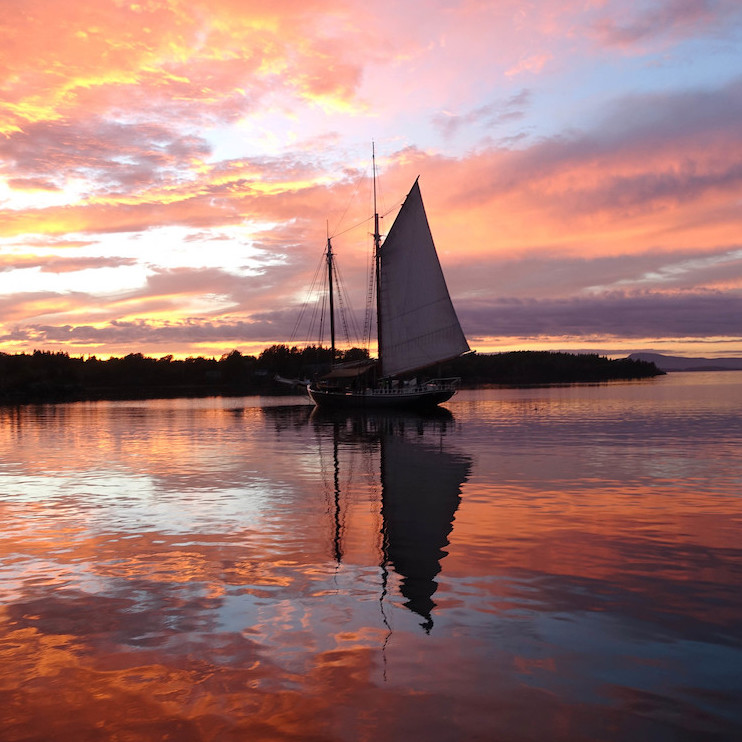
A windjammer cruise around the coast of Maine is the relaxing vacation of your dreams. Sailing past rocky islands, the azure sky above, the sails billowing in the wind, and lobsters with melted butter: you couldn’t ask for more. Even if you’ve never been to Maine, you might know the state is famous for lobster. 90 percent of the United States lobster supply comes from Maine. Still, you’d be surprised to learn that before the crustacean became an iconic delicacy, lobsters were fed to prison inmates or ground up and used as fertilizer.
Videos by TravelAwaits
I’ve traveled to the Pine Tree State before but never spent time on the water. When offered the opportunity to sail around the tiny coves and into Penobscot Bay for four idyllic days, I jumped at the chance. After all, it’s a place with a long maritime history. Schooners from Maine carried cargo along the Eastern seaboard and as far away as Asia in the 1800s. The Lobster and Lighthouses sail on the J. & E. Riggin, a historic schooner departing from Rockport, Maine, was an experience I couldn’t pass up. If you love historic ships and want to experience the romance of sailing along coastal Maine, here are some things to know before embarking on a Maine Windjammer Cruise.
Note: I was a guest on the J. & E. Riggin for the four-day Lobster and Lighthouse Cruise. All opinions are my own.
1. Windjammers Are Powered By Sails
Also referred to as tall ships, windjammers are commercial sailing ships with multiple masts. They have no engines and are powered by the wind and tides. Today, this provides a relaxing sailing experience with no real destination. When you sail, you go where the wind takes you around Maine’s rocky coast. If there’s no wind (the doldrums) there’s a yawl boat, a small gas-powered boat rigged or tugged behind the sailboat for assistance. The yawl boat is used for runs to shore and when there’s no wind. When we hit the doldrums, the Riggin used its 16-foot diesel yawl boat to push the schooner along. When there was a strong wind, we sailed around 9 miles per hour, or 8 knots, which was a thrill.

2. Many Windjammers Are National Historic Landmarks
The Riggin was built in 1927 as an oyster dredger in the Delaware Bay. She was built by Charles Riggin in Dorchester, New Jersey and named for his sons Jacob and Edward. The Riggin finished first ahead of all the other oyster-schooners in the only formal race ever held in 1929. She was registered as a National Historic Landmark Vessel in 1991. There’s a plaque on the deck commemorating her status. Most of the windjammers in the Maine Windjammer Association are National Historic Landmarks. With the wind in her sails, the Riggin is as graceful as ever.

3. Windjammers Are Eco-Conscious
Sailing is a sustainable way to travel. The Riggin was given the Environmental Leadership in Hospitality award by the State of Maine —the first and only windjammer to be given the honor. Many sustainable practices are in place for sailing. We were welcomed to select a mug for the trip, ours to wash and use for the journey. We scraped our leftovers for composting after meals. Each passenger washed plates and utensils in dedicated buckets on deck. Paper plates were used during our beach lobster bake, but composting was implemented, stainless utensils were washed, and paper products recycled.

4. Guests Help Sail The Schooners
I read that hoisting the sails and sailing the historic schooner is part of the experience on Maine windjammer cruises. Our initiation began on the first day. The first mate gave us a lesson on how to help raise the sails and split guests into two groups. One group helped raise the throat on one side, and one group helped raise the peak on the other. Our crew yelled out, “Heave,” and we called back, “Ho,” and as the sails were raised, the Riggin was underway. Other passengers volunteered to hoist the anchor (a demanding job). Some of the youngest passengers watered the anchor chain or raised the American flag. If you don’t want to assist, that’s up to you, but on a smaller boat, it’s all-hands-on-deck. The Riggin‘s crew needed help, and guests jumped in to support. Every passenger agreed they enjoyed this aspect of windjamming. I asked Captain Justin if I could take a turn at the wheel and was surprised by the power of the schooner. I enjoyed it, and soon many of the guests steered the Riggin.

5. Windjamming Is Elegant Camping
If you like camping, you’ll love windjamming. I liked the prospect of sleeping on a boat, especially under the stars, and brought a sleeping bag to try it. The Riggin is 90 feet long on deck, 120 feet overall, and 23 feet wide with a large galley. There are two bathrooms on deck, and one has a shower. It’s a smaller vessel and usually accommodates 24 passengers, but for our sail, we had 14. The crew kept it spick-and-span, shining the brass and swabbing the deck. It truly is an elegant form of camping as the ship is an antique. The berths are cozy and include a small sink and window. The room allows for rest and storage, and you are meant to spend your time up top admiring the gorgeous scenery. Relaxing pursuits such as reading, sketching, crafting, using binoculars to scope out ospreys or eagles, or watching the waves for porpoises and seals take up the day. We saw a lot of wildlife on our journey, and the sightings never got old. There’s a canvas tarp that allows for shade on the deck. It was up most of the day but removed other times for maximum sailing pleasure.

6. The Food Is Ultra-Local
When I say local, I mean just-plucked lobster from Stonington, Maine. On our second day, we stopped off in the charming coastal town. Passengers got off the boat to explore while the crew purchased our dinner for later that evening. Then we sailed to Hell’s Half Acre Island and anchored. Captain Justin used the yawl boat to transport us to the campground for a generous spread of lobster, corn, potatoes, paella, and a traditional dessert of s’mores roasted over the fire. For the entire voyage, we were treated to family-style, made-from-scratch meals crafted by Chef Mark Godfrey and Sous Chef Kat Highley. Everything is prepared on the Crawford Cottage wood-burning cookstove in a tiny kitchen. Ingredients are farm-to-table, including Captain Jocelyn’s garden. Maine’s blueberries were a highlight on our trip, as well as bespoke oysters from Adam Campbell’s North Haven Oyster Company. Adam came aboard to teach us how to shuck and slurp the fresh, briny oysters he cultivates in the salt ponds in North Haven, Maine. The food was delicious, plentiful, and there were always extra snacks if needed.

7. Windjammers Are Owner Operated And Unique
Even though the boats belong to an association of windjammers, each ship is owner-operated. It’s their independent business, and they take pride in making sure you have the best experience possible. To pick the appropriate boat for your vacation, you should review the description of each windjammer and the layout of the cabins. The overall experience is the same; expect a relaxing cruise in and around the waters of coastal Maine. Each cruise serves a lobster bake either on a beach or in the galley of the boat. Some cruises offer different options for entertainment, crafts, photography, or stargazing. Some are multi-generational or adults only. Read the biography about each captain as well. It’s important to know who you are sailing with and to feel comfortable with their credentials. Captains Justin and Jocelyn of the Riggin are married with many years of experience sailing and crewing on windjammers and private yachts.
Windjammer Pro Tips
Windjammers offer the chance to unplug and leave electronics behind. There’s electricity on the schooners and Wi-Fi in port, but cell service is spotty, especially when sailing. It’s geared for relaxation.
The berths are meant for sleeping. There’s not a lot of space to hang out in your room. So socializing, reading, scoping wildlife, or napping on deck is the daily routine.
Wine, beer, and liquor are not provided, but storage and ice are. Bring your own.
Special diets should be discussed before planning a sail.
People with mobility issues may find it challenging to navigate a sailboat. Steep ladders and tight spaces make it difficult to get up and down to sleeping cabins, or on and off the boat for excursions. Review the specifications for each windjammer.
Windjammers offer a specific type of experience. Check to make sure you have reviewed the activities included. For example, active travelers may want to have options for exercise, while other travelers may want more passive pursuits.
Many cruises sail with families. You might be interested in a cruise with multi-generational opportunities. Check with the boat of your choice to make sure children are permitted.
Sunny days and smooth sailing call for hats, sunglasses, and sunscreen. Weather changes require layers that you will peel off and reapply throughout the day. Rainy days and fog are also common.
